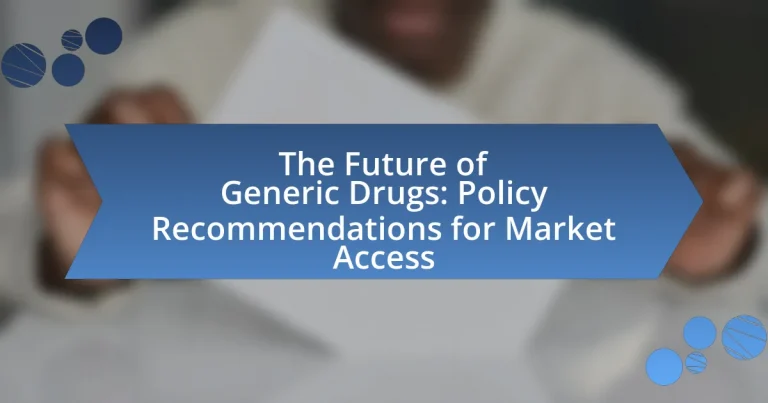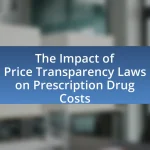The article focuses on the future of generic drugs, emphasizing their critical role in enhancing market access and affordability within the healthcare system. It outlines the regulatory frameworks, such as the FDA’s initiatives, that facilitate faster approval processes for generics and biosimilars, which are expected to expand treatment options. Key challenges, including patent laws and market competition, are discussed alongside policy recommendations aimed at improving access to generic medications. The article highlights the significant cost savings generics provide to the healthcare system and the importance of collaboration among stakeholders to enhance their availability and adoption.
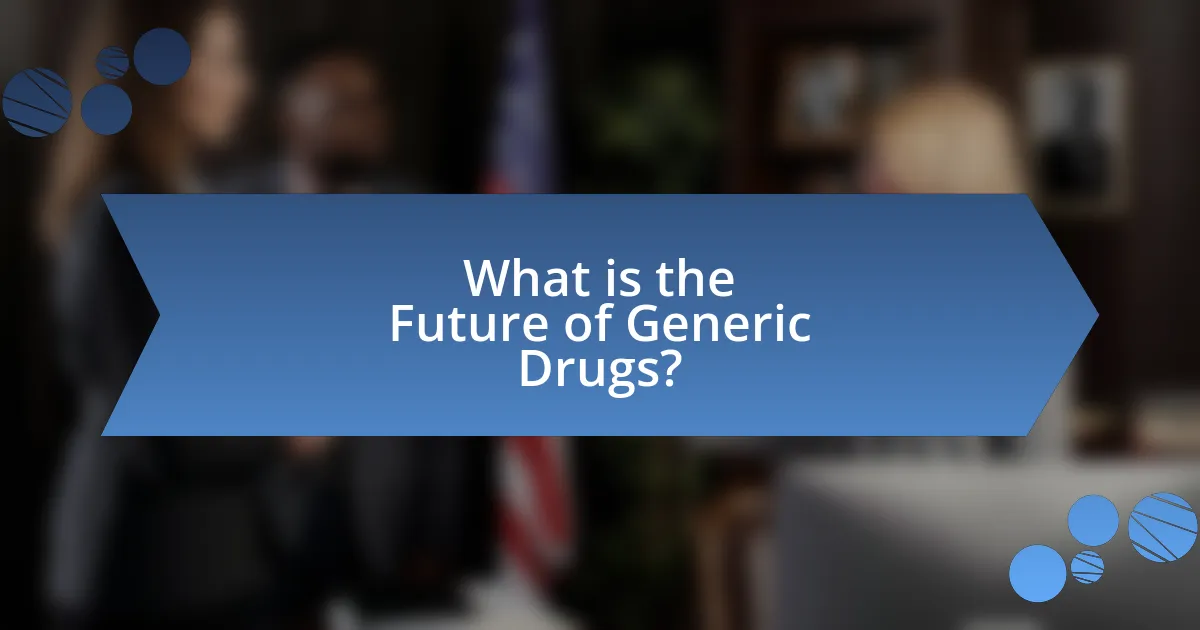
What is the Future of Generic Drugs?
The future of generic drugs is expected to see increased market access and competition, driven by policy reforms and technological advancements. Regulatory agencies, such as the FDA, are implementing measures to streamline the approval process for generics, which can lead to faster entry into the market. For instance, the FDA’s Generic Drug User Fee Amendments (GDUFA) have significantly reduced the backlog of generic applications, enhancing the availability of affordable medications. Additionally, the rise of biosimilars, which are generic versions of biologic drugs, is anticipated to expand the generic market further, providing more treatment options at lower costs. This trend is supported by data indicating that generics save the U.S. healthcare system over $300 billion annually, highlighting their critical role in improving access to medications.
How are generic drugs defined in the current market?
Generic drugs are defined in the current market as medications that are equivalent to brand-name drugs in dosage form, strength, route of administration, quality, performance characteristics, and intended use, but are marketed under their chemical name rather than a brand name. The U.S. Food and Drug Administration (FDA) requires that generic drugs demonstrate bioequivalence to their brand-name counterparts, meaning they must deliver the same amount of active ingredients into a patient’s bloodstream in the same amount of time. This regulatory framework ensures that generic drugs are safe, effective, and of high quality, contributing to increased access and affordability in the pharmaceutical market.
What distinguishes generic drugs from brand-name drugs?
Generic drugs are distinguished from brand-name drugs primarily by their lack of brand identity and the requirement to be chemically identical to their brand-name counterparts. Generic drugs contain the same active ingredients, dosage form, strength, and route of administration as brand-name drugs, but they are marketed under their chemical name or a different name without the branding. The U.S. Food and Drug Administration (FDA) mandates that generic drugs demonstrate bioequivalence to the brand-name drug, ensuring that they perform in the same manner in the body. This regulatory framework supports the validity of generics as effective alternatives, often at a significantly lower cost, which enhances market access and affordability for consumers.
What role do generic drugs play in healthcare systems?
Generic drugs play a crucial role in healthcare systems by providing cost-effective alternatives to brand-name medications, thereby improving access to essential treatments. They contribute to reducing overall healthcare costs; for instance, the U.S. Federal Trade Commission reported that generic drugs saved consumers and the healthcare system approximately $293 billion in 2016 alone. By increasing competition in the pharmaceutical market, generic drugs help lower prices and enhance patient adherence to prescribed therapies, ultimately leading to better health outcomes.
Why is the future of generic drugs significant?
The future of generic drugs is significant because they provide affordable access to medications, which can improve public health outcomes. Generic drugs account for approximately 90% of all prescriptions in the United States, leading to substantial savings for patients and healthcare systems, estimated at $338 billion in 2020 alone. This affordability encourages adherence to treatment regimens, ultimately reducing hospitalizations and healthcare costs. Additionally, the continued development of generics fosters competition in the pharmaceutical market, driving innovation and ensuring that patients have access to a wider range of treatment options.
How do generic drugs impact healthcare costs?
Generic drugs significantly reduce healthcare costs by providing lower-priced alternatives to brand-name medications. According to a study by the AARP Public Policy Institute, generic drugs saved the U.S. healthcare system approximately $338 billion in 2016 alone. This cost reduction occurs because generics enter the market after the patent protection of brand-name drugs expires, leading to increased competition and lower prices. Furthermore, the availability of generics encourages more patients to adhere to prescribed treatments, ultimately improving health outcomes and reducing overall healthcare expenditures.
What are the implications for patient access to medications?
Patient access to medications is significantly influenced by the availability and affordability of generic drugs. The introduction of generic medications typically leads to lower prices, which enhances access for patients, particularly those with limited financial resources. According to a study by the Generic Pharmaceutical Association, generic drugs saved the U.S. healthcare system $338 billion in 2016 alone, demonstrating their critical role in improving access to essential medications. Furthermore, policies that promote market access for generics can reduce barriers such as high costs and limited availability, ultimately leading to better health outcomes for patients.
What challenges do generic drugs face in market access?
Generic drugs face significant challenges in market access, primarily due to regulatory hurdles, patent litigation, and market competition. Regulatory hurdles include complex approval processes that can delay entry into the market; for instance, the FDA’s Abbreviated New Drug Application (ANDA) process requires extensive documentation and testing to ensure bioequivalence to the brand-name drug. Patent litigation poses another challenge, as brand-name manufacturers often engage in legal battles to extend their market exclusivity, which can prevent generics from entering the market even after patents expire. Additionally, intense market competition can lead to price erosion, making it difficult for generic manufacturers to sustain profitability. These factors collectively hinder the timely availability of affordable generic medications to consumers.
What regulatory hurdles exist for generic drug approval?
Regulatory hurdles for generic drug approval include the requirement for demonstrating bioequivalence to the brand-name drug, compliance with Good Manufacturing Practices (GMP), and navigating the complex patent landscape. The U.S. Food and Drug Administration (FDA) mandates that generic drugs must have the same active ingredients, dosage form, strength, and route of administration as their branded counterparts, which can be challenging due to the need for extensive clinical data. Additionally, manufacturers must adhere to stringent GMP regulations to ensure product quality and safety. Furthermore, the presence of patents and exclusivities can delay market entry, as generics cannot be approved until the relevant patents expire or are successfully challenged. These regulatory requirements are designed to ensure that generics are safe and effective, but they can also create significant barriers to entry for manufacturers.
How do patent laws affect the availability of generic drugs?
Patent laws significantly restrict the availability of generic drugs by granting exclusive rights to patent holders for a specified period, typically 20 years. During this time, generic manufacturers cannot produce or sell copies of the patented drug, which limits competition and keeps prices high. For instance, the Hatch-Waxman Act in the United States allows for a 180-day exclusivity period for the first generic applicant after the patent expires, but until that point, generics cannot enter the market. This legal framework directly impacts the accessibility of affordable medications, as evidenced by studies showing that generic entry can reduce drug prices by up to 80%.
How can policy recommendations improve market access for generic drugs?
Policy recommendations can improve market access for generic drugs by streamlining regulatory processes and enhancing pricing transparency. Streamlined regulatory processes, such as expedited approval pathways for generics, can reduce the time and cost associated with bringing these drugs to market. For instance, the U.S. Food and Drug Administration (FDA) has implemented the Generic Drug User Fee Amendments, which have led to faster review times for generic applications. Enhanced pricing transparency allows healthcare providers and consumers to make informed choices, fostering competition among generic manufacturers. According to a study by the Federal Trade Commission, increased competition from generics can lead to significant price reductions, benefiting patients and healthcare systems.
What specific policies can enhance competition in the generic drug market?
Implementing policies that streamline the approval process for generic drugs can significantly enhance competition in the generic drug market. For instance, the FDA’s Generic Drug User Fee Amendments (GDUFA) have expedited the review of generic applications, leading to a 50% increase in approvals from 2012 to 2019. Additionally, policies that promote transparency in pricing and encourage the entry of multiple generic manufacturers can further stimulate competition. Evidence shows that when more generics enter the market, prices drop; for example, the introduction of a second generic competitor can reduce prices by 30% or more. Furthermore, enforcing anti-competitive practices, such as pay-for-delay agreements, can prevent brand-name companies from hindering generic entry, thereby fostering a more competitive environment.
How can government initiatives support generic drug manufacturers?
Government initiatives can support generic drug manufacturers by implementing policies that enhance market access and reduce barriers to entry. For instance, streamlined regulatory processes can expedite the approval of generic drugs, allowing manufacturers to bring products to market more quickly. Additionally, financial incentives such as grants or tax breaks can lower operational costs for these manufacturers, encouraging innovation and competition. Evidence from the Generic Pharmaceutical Association indicates that the introduction of generics has saved the U.S. healthcare system over $1.67 trillion from 2007 to 2016, demonstrating the significant impact of supportive government policies on market dynamics and consumer access to affordable medications.
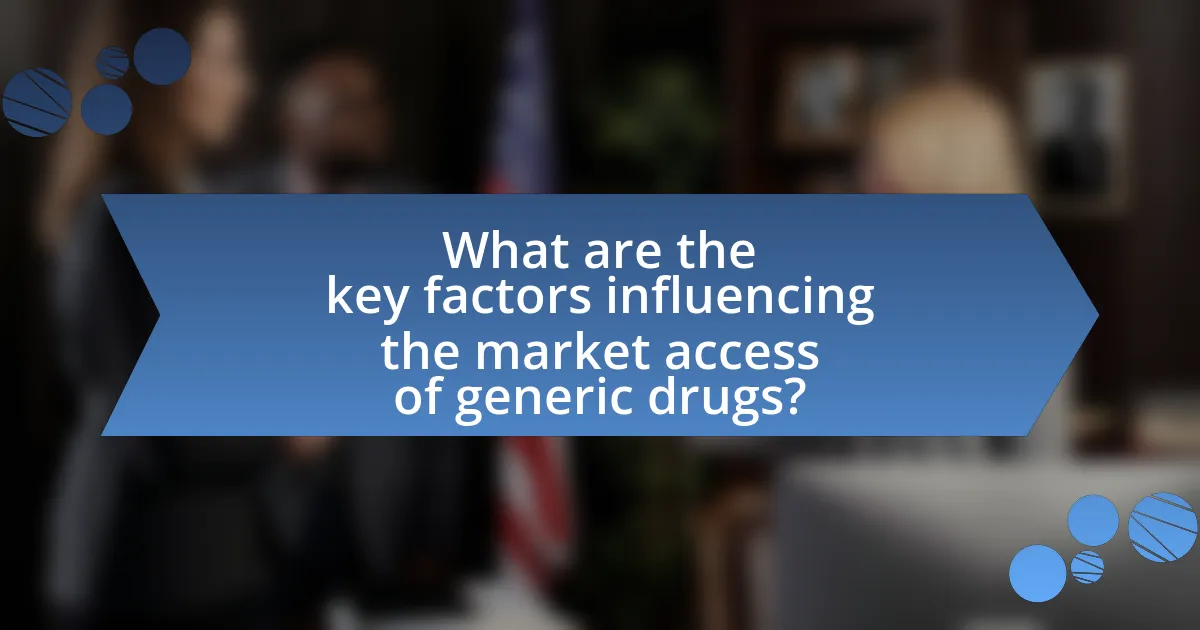
What are the key factors influencing the market access of generic drugs?
The key factors influencing the market access of generic drugs include regulatory approval processes, pricing strategies, patent expirations, and market competition. Regulatory approval processes, such as the requirements set by the FDA, determine how quickly generics can enter the market after the original drug’s patent expires. Pricing strategies, including the ability to offer lower prices than brand-name drugs, significantly affect market penetration. Patent expirations create opportunities for generics to enter the market, as they can only be marketed once the original drug’s patent protection ends. Lastly, market competition among generic manufacturers can drive prices down and improve access, as seen in markets with multiple generic options available.
How does pricing strategy affect generic drug market access?
Pricing strategy significantly influences generic drug market access by determining affordability and competitive positioning. When generic drugs are priced lower than their brand-name counterparts, they become more accessible to consumers and healthcare providers, leading to increased market penetration. For instance, a study published in the Journal of Managed Care & Specialty Pharmacy found that a 10% reduction in generic drug prices can lead to a 5% increase in utilization, demonstrating the direct correlation between pricing and access. Additionally, effective pricing strategies can enhance the attractiveness of generics to pharmacy benefit managers and insurers, further facilitating market entry and adoption.
What pricing models are most effective for generic drugs?
The most effective pricing models for generic drugs include cost-plus pricing, value-based pricing, and competitive pricing. Cost-plus pricing involves setting prices based on production costs plus a markup, ensuring that manufacturers cover expenses while remaining profitable. Value-based pricing considers the therapeutic benefits and cost savings that generics provide compared to brand-name drugs, allowing for higher prices when significant value is demonstrated. Competitive pricing focuses on setting prices in line with or slightly below competitors to capture market share. These models are supported by data showing that generics can reduce healthcare costs significantly; for example, the FDA reported that generic drugs saved the U.S. healthcare system $338 billion in 2016 alone.
How do discounts and rebates influence market dynamics?
Discounts and rebates significantly influence market dynamics by altering pricing strategies and consumer behavior. These financial incentives can lead to increased sales volume as consumers are more likely to purchase products that are perceived as offering better value. For instance, a study by the National Bureau of Economic Research found that discounts can increase demand by up to 30%, demonstrating their effectiveness in driving market activity. Additionally, discounts and rebates can create competitive pressure among manufacturers, prompting them to innovate or reduce prices to maintain market share. This competitive landscape ultimately benefits consumers through lower prices and increased product availability.
What role does healthcare policy play in generic drug accessibility?
Healthcare policy significantly influences generic drug accessibility by establishing regulations that govern drug approval, pricing, and market entry. These policies can facilitate or hinder the availability of generics through measures such as patent laws, which determine the duration of exclusivity for brand-name drugs, and the implementation of programs that encourage the use of generics, such as formulary management and cost-sharing strategies. For instance, the Drug Price Competition and Patent Term Restoration Act of 1984 in the United States, also known as the Hatch-Waxman Act, was pivotal in promoting generic drug entry by allowing abbreviated new drug applications (ANDAs), which streamline the approval process for generics. This legislation has led to a significant increase in generic drug utilization, with generics accounting for approximately 90% of all prescriptions filled in the U.S. by 2021, thereby demonstrating the critical role that healthcare policy plays in enhancing access to affordable medications.
How can healthcare reforms facilitate generic drug adoption?
Healthcare reforms can facilitate generic drug adoption by implementing policies that enhance market access and reduce barriers to entry for generic manufacturers. For instance, reforms that streamline the approval process for generics can significantly decrease the time and cost associated with bringing these drugs to market. According to a study by the FDA, the introduction of the Generic Drug User Fee Amendments has expedited the review process, leading to a 50% increase in generic drug approvals from 2012 to 2017. Additionally, reforms that promote price transparency and encourage competition among generic manufacturers can lower drug prices, making generics more appealing to both healthcare providers and patients. Evidence from the National Bureau of Economic Research indicates that states with policies supporting generic substitution see a higher utilization rate of generics, which further supports the case for healthcare reforms aimed at enhancing generic drug adoption.
What are the best practices for integrating generics into formularies?
The best practices for integrating generics into formularies include establishing clear guidelines for evaluating the clinical efficacy and cost-effectiveness of generic medications, ensuring that formularies are updated regularly to reflect the latest evidence and market changes, and engaging stakeholders such as healthcare providers and patients in the decision-making process. These practices are supported by studies showing that formularies that prioritize generics can lead to significant cost savings for healthcare systems; for instance, a report from the Generic Pharmaceutical Association indicates that the use of generics saved the U.S. healthcare system over $338 billion in 2016 alone. Additionally, implementing educational initiatives for prescribers about the benefits and safety of generics can enhance acceptance and utilization, further promoting their integration into formularies.
How can stakeholders collaborate to enhance generic drug access?
Stakeholders can collaborate to enhance generic drug access by forming partnerships that streamline regulatory processes, share data on market needs, and promote educational initiatives. For instance, pharmaceutical companies can work with regulatory agencies to expedite the approval of generic drugs, reducing time to market. Additionally, healthcare providers and payers can collaborate to create awareness about the benefits of generics, leading to increased acceptance among patients. Evidence shows that countries with strong public-private partnerships, such as Canada, have successfully improved access to generics, resulting in lower healthcare costs and better patient outcomes.
What partnerships can be formed between manufacturers and healthcare providers?
Manufacturers and healthcare providers can form partnerships focused on collaborative research and development, supply chain optimization, and education initiatives. Collaborative research allows manufacturers to work with healthcare providers to develop new generic drugs that meet specific patient needs, enhancing treatment options. Supply chain optimization partnerships can streamline the distribution of generic drugs, ensuring timely access to medications for patients. Education initiatives can involve training healthcare providers on the benefits and proper use of generic drugs, which can improve patient adherence and outcomes. These partnerships are essential for increasing market access and ensuring that generic drugs effectively meet healthcare demands.
How can patient advocacy groups influence policy changes?
Patient advocacy groups can influence policy changes by mobilizing public support, providing expert testimony, and engaging in lobbying efforts. These groups often represent the interests of patients and can effectively raise awareness about specific health issues, thereby shaping public opinion and prompting policymakers to take action. For instance, the American Cancer Society has successfully advocated for legislation that improves access to cancer treatments, demonstrating the power of organized patient voices in the legislative process. Additionally, research shows that advocacy efforts can lead to significant policy shifts, such as the expansion of insurance coverage for generic drugs, which ultimately benefits patient access and affordability.
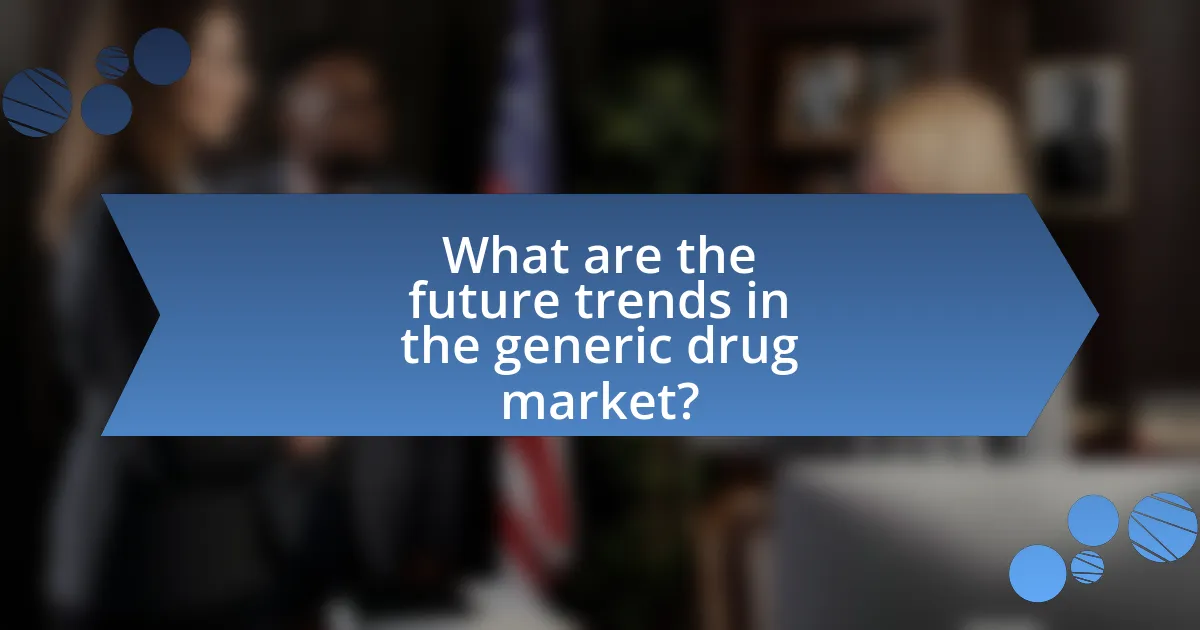
What are the future trends in the generic drug market?
The future trends in the generic drug market include increased competition, technological advancements, and a growing emphasis on biosimilars. Increased competition is driven by the expiration of patents for numerous blockbuster drugs, which allows more generic manufacturers to enter the market. Technological advancements, such as improved manufacturing processes and digital health integration, are expected to enhance efficiency and reduce costs. Additionally, the rise of biosimilars, which are biologic medical products highly similar to already approved reference products, is anticipated to expand the generic market further, as they offer more treatment options at lower prices. According to a report by IQVIA, the global generic drug market is projected to reach $500 billion by 2025, reflecting these trends and the increasing demand for affordable medications.
How is technology shaping the development of generic drugs?
Technology is significantly shaping the development of generic drugs by enhancing efficiency in drug formulation and production processes. Advanced technologies such as artificial intelligence and machine learning streamline the drug discovery process, allowing for quicker identification of viable generic candidates. Additionally, innovations in manufacturing techniques, like continuous manufacturing and 3D printing, reduce production costs and time, making it easier for companies to bring generics to market. For instance, the FDA has noted that the use of modern manufacturing technologies can lead to more consistent product quality and lower barriers to entry for generic drug manufacturers.
What innovations are emerging in generic drug manufacturing?
Innovations emerging in generic drug manufacturing include advanced manufacturing technologies such as continuous manufacturing, 3D printing, and the use of artificial intelligence for process optimization. Continuous manufacturing allows for more efficient production processes, reducing costs and time to market. For instance, the FDA has recognized continuous manufacturing as a means to enhance drug quality and supply chain reliability. 3D printing enables the customization of drug formulations and dosages, catering to specific patient needs, which has been demonstrated in recent studies showing improved patient adherence. Additionally, artificial intelligence is being utilized to analyze large datasets for better decision-making in drug development and production, leading to more streamlined operations and reduced waste. These innovations collectively enhance the efficiency, quality, and accessibility of generic drugs in the market.
How can digital health tools improve access to generic medications?
Digital health tools can improve access to generic medications by enhancing patient engagement and streamlining the prescription process. These tools, such as mobile health applications and telemedicine platforms, facilitate easier communication between patients and healthcare providers, allowing for timely access to necessary prescriptions. For instance, a study published in the Journal of Medical Internet Research found that telehealth services increased medication adherence by 30%, demonstrating that digital platforms can effectively connect patients with generic medication options. Additionally, digital health tools can provide patients with information on the availability and pricing of generic drugs, further reducing barriers to access.
What are the potential impacts of global trade on generic drugs?
Global trade significantly impacts generic drugs by influencing their availability, pricing, and market competition. Increased global trade can lead to lower prices for generic drugs due to enhanced competition among manufacturers and access to larger markets. For instance, the World Trade Organization’s Trade-Related Aspects of Intellectual Property Rights (TRIPS) agreement facilitates the production and distribution of generics, allowing countries to bypass patents under certain conditions. This has resulted in a 90% reduction in the cost of antiretroviral drugs for HIV/AIDS in low-income countries since the early 2000s. Additionally, global trade can improve access to essential medicines in developing regions, as seen in the proliferation of generic antimalarials and antibiotics. However, trade policies can also pose challenges, such as potential barriers to market entry and the risk of monopolistic practices by large pharmaceutical companies.
How do international agreements affect generic drug availability?
International agreements significantly influence generic drug availability by establishing intellectual property rights and trade regulations that can either facilitate or hinder market access. For instance, agreements like the Trade-Related Aspects of Intellectual Property Rights (TRIPS) set minimum standards for patent protection, which can delay the entry of generic drugs into the market by extending the exclusivity period for brand-name pharmaceuticals. Conversely, provisions within some trade agreements may promote the use of generics by allowing countries to bypass certain patent protections under specific conditions, thereby enhancing access to affordable medications. Evidence from the World Health Organization indicates that countries with flexible patent laws often see a higher availability of generic drugs, demonstrating the direct impact of international agreements on market dynamics.
What challenges do global supply chains pose for generic drugs?
Global supply chains pose significant challenges for generic drugs, primarily due to regulatory complexities, quality control issues, and supply chain disruptions. Regulatory complexities arise from varying standards and requirements across different countries, which can delay the approval and distribution of generic drugs. Quality control issues are heightened when sourcing raw materials from multiple international suppliers, increasing the risk of contamination or substandard products. Additionally, supply chain disruptions, such as those caused by geopolitical tensions or natural disasters, can lead to shortages of essential ingredients, impacting the availability of generic medications. These challenges hinder timely access to affordable medications, ultimately affecting patient care and public health outcomes.
What practical steps can be taken to ensure better access to generic drugs?
To ensure better access to generic drugs, policymakers should implement streamlined regulatory processes that facilitate quicker approval of generics. For instance, the U.S. Food and Drug Administration (FDA) has established the Abbreviated New Drug Application (ANDA) pathway, which allows for faster entry of generics into the market, thereby increasing competition and lowering prices. Additionally, enhancing transparency in pricing and promoting the use of generics through public awareness campaigns can further drive adoption. Studies indicate that when patients are educated about the efficacy and safety of generics, their acceptance increases, leading to higher utilization rates.
What strategies can patients use to advocate for generic options?
Patients can advocate for generic options by actively engaging with healthcare providers, educating themselves about the benefits of generics, and participating in community discussions. Engaging with healthcare providers allows patients to express their preferences for generic medications, which can influence prescribing practices. Educating themselves about the efficacy and safety of generics, supported by studies showing that generics are bioequivalent to brand-name drugs, empowers patients to make informed decisions. Additionally, participating in community discussions or advocacy groups can amplify their voices, leading to broader awareness and support for generic options.
How can healthcare providers promote the use of generics effectively?
Healthcare providers can effectively promote the use of generics by educating patients about their safety, efficacy, and cost-effectiveness compared to brand-name drugs. Research indicates that patients who receive information about the equivalence of generics to brand-name medications are more likely to choose generics, leading to significant savings; for instance, the FDA reports that generics can save consumers up to 80% on medication costs. Additionally, healthcare providers can implement prescribing practices that favor generics, such as using electronic health records to default to generic options and discussing the benefits of generics during consultations. By actively engaging in these practices, healthcare providers can enhance patient trust in generics and contribute to broader market access for these medications.
